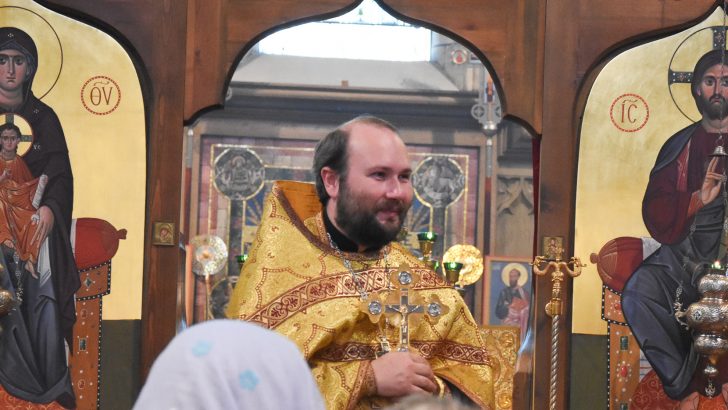Leaving behind a life destined for the military, the priest of one of Ireland’s most established Orthodox Churches pursued a life of piety despite the odds.
Fr Mikhail Nasonov, of the Russian Orthodox Church, operates in Ireland at a time when Christian Orthodoxy is the fastest growing religion. Between the 2011 and 2016 census the number of Orthodox worshippers in Ireland has risen by 37.5%. This is believed to be due to immigration rather than conversion, as Ireland’s communities diversify.
Fr Nasonov was born in 1973 at a time when religion was persecuted in the former Soviet Union, and his father was a communist. His first introduction to Christianity was when he came across the story of Lazarus in Dostoevsky’s Crime and Punishment, he told The Irish Catholic: “I was very impressed by this story and I started to find out more about Christ.”
Gospel
The first time he read the Gospel was when he was in military school. “I tried to find the Gospel to read because it wasn’t easy at that time, I remember I had a friend who asked an artist to find us a Bible,” Fr Nasonov said.
“In the army you should be like the others, so you have to confess the same values as other people. I remember we read this Gospel, these small books, on the nights when nobody could see us.
“It wasn’t completely illegal, it wasn’t a crime, but you can have trouble because in the army there was a special department to control the ideological thinking,” he added.
He left military school to become Christian at the age of 18, and was baptised. Fr Nasonov entered the seminary in St Petersburg and studied Theology and Russian, then studied in Paris at the St Sergius Orthodox Theological Institute, and lectured in Theology in Moscow. He was subsequently sent to serve in Ireland.
The first Orthodox priest in Ireland is thought to have been from the Russian Orthodox Church. Fr Nicholas Couriss, who fled Russia after the country’s revolution in 1917 which saw the fall of the Tsar, had a parish in Dublin in 1969.
The Russian Orthodox Church is in full communion with the Eastern Orthodox Churches, such as the Antiochian, Romanian, Georgian, Serbian and Greek Orthodox to name a few. They are all autocephalous, which means the patriarch of each Church (similar to the Pope) does not report to any higher ranking bishop. This is one of the main reasons, aside from minor theological differences, the Catholic and Orthodox Churches split – because the Orthodox did not accept the primacy of the Pope.
After Fr Couriss’ parish closed when he died in 1977, the Russian Orthodox shared a Church with the Greek Orthodox. This changed when Fr Nasonov was tasked by the Diocese of Sourozh (which encompasses Britain and Ireland) to raise €50,000 to buy a church from the Church of Ireland. He was successful and now they own the Holy Apostles Peter and Paul Church in Harold’s Cross, Dublin.
Not only does it provide a place of worship for Russian nationals, but many Eastern Europeans regularly attend as well.
“We have people from different countries in our parish, it’s not just Russians. The thing is there’s not many Russians here in Ireland, it’s mostly people from the Baltic States,” said Fr Nasonov. “There’s a lot of people from Latvia, Lithuania, Moldova, from Ukraine and from Serbia.”
The Russian Orthodox Church in Ireland is a young Church, with many families attending, and there is a parish education centre which is split up into four parts.
There is a Sunday school for children, where they read scripture and do activities relating to faith and religion – such as plays. They also have theological classes for adults and a music school.
A Russian language school is also provided, with Fr Nasonov saying “it is for our children to keep their language, because it’s very easy to lose. When you go to Irish schools you speak English all the time”.
The Russian Orthodox would usually try to go to Confession before receiving Communion, with Fr Nasonov saying people would go to Confession more often than in the Catholic Church.
He added: “We give the Communion from the beginning, so after the Baptism even the little babies can take the Communion, but when they’re just one month old – just the blood of Christ.”
Fr Nasonov is married with children which is common for priests in the Eastern Orthodox Church, but there are also celibate priests, as priests can only have a wife once they are married before they are ordained.
“We can only be married once, the idea is that the priest can be an example for the people, an example in his private life, in his family life as well, theoretically: maybe in reality it is not always the case,” Fr Nasonov said.
Fr Nasonov praised the Catholic Church, and Archbishop of Dublin, Dr Diarmuid Martin in particular, for the help many of the Orthodox churches have been given throughout the years, even now some Orthodox worshippers share Catholic churches and facilities.
“We have to keep these Christian values for society, we have the same Christian values, Protestants as well. We have to witness the Gospels together,” said Fr Nasonov.
“Especially now when the attitude is not very friendly to Christians so we have to support each other, this is clear,” he added.


 Chai Brady
Chai Brady Fr Mikhail Nasonov
Fr Mikhail Nasonov 
